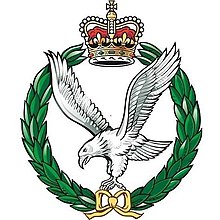
Back Army Air Corps Czech Corfflu Awyr y Fyddin Welsh Army Air Corps (British Army) German سپاه هوایی ارتش بریتانیا Persian Army Air Corps French זרוע האוויר של הצבא (הממלכה המאוחדת) HE Բանակային ավիացիայի կորպուս Armenian Army Air Corps (Britania Raya) ID Army Air Corps Italian 陸軍航空隊 (イギリス) Japanese
| Army Air Corps | |
|---|---|
 Cap Badge of the Army Air Corps. | |
| Active | 1942–1949 1957–present |
| Country | |
| Branch | |
| Type | Army aviation |
| Role | Battlefield support, reconnaissance |
| Size | 2,000 personnel Approx. 150 aircraft[1] |
| Garrison/HQ | Middle Wallop Flying Station |
| March | Quick: Recce Flight Slow: Thieving Magpie |
| Battle honours | Falkland Islands 1982 Wadi al-Batin, Gulf 1991 Basra, Iraq 2003 |
| Commanders | |
| Colonel-in-Chief | William, Prince of Wales |
| Colonel Commandant | Lieutenant General Sir Nicholas Borton |
| Insignia | |
| Tactical Recognition Flash |  |
| Aircraft flown | |
| Attack | Apache AH-64E V6 |
| Reconnaissance | Wildcat AH1 |
| Trainer | Jupiter HT1 Juno HT1 |
| Transport | AS365N3 Dauphin II |
The Army Air Corps (AAC) is the aviation arm of the British Army, first formed in 1942 during the Second World War by grouping the various airborne units of the British Army. Today, there are eight regiments (seven Regular Army and one Reserve) of the AAC, as well as two independent flights and two independent squadrons deployed in support of British Army operations around the world. Regiments and flights are located in the United Kingdom, Kenya, and Canada. Some AAC squadrons provide the air assault elements of 16 Air Assault Brigade Combat Team, through Joint Aviation Command.
- ^ "World Air Forces" (PDF). Flight International. 2014. Archived (PDF) from the original on 26 October 2018. Retrieved 25 August 2014.